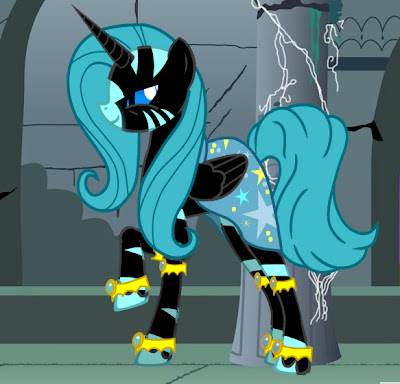Today, we worked on tuning them, as well as pick practice (how to hold and use a pick), and then they plucked out "Ode to Joy."
IN STITCHES: I've been meaning to share this photo for a few days now. We're definitely Mars-minded, what with Curiosity speeding ever-closer to the Red Planet. Here's what awaits MSL ...
The photo above is a composite of 817 component images taken between Dec. 21, 2011, and May 8, 2012 and then stitched together. In the composite photo, you can see fresh rover tracks from the photographer, rover Opportunity, as well as an impact crater blasted billions of years ago. The photo was composed by taking images from the panoramic camera (Pancam) mounted on Opportunity, while the rover was stationed on an outcrop informally named "Greeley Haven," which is on a segment of the rim of ancient Endeavour Crater.
Earlier this month (on July 2), Opportunity completed its 3,000th Martian day on July 2. Also this month (on July 4, in fact), NASA marked 15 years of continuous robotic presence on Mars. (Mars Pathfinder landed July 4, 1997.)
To see the really big version of the photo, go to: http://photojournal.jpl.nasa.gov/catalog/PIA15689 .
RESOURCE-O-RAMA: This morning we sat in on a NASA Educators Online Network (NEON) Webinar called "Missions to Planet Earth:
Remote Sensing: Using Satellites to Observe Changes Over Time"
Rick Varner of Goddard Spaceflight Center was the host. He reviewed how to use NASA and USGS Web sites for historic and current satellite imagery of Earth.
Garner shared some remarkable images with us (many from the Landsat Program -
http://www.nasa.gov/landsat and http://landsat.usgs.gov/), and told us where to go to find a whole lot more material to work with. For instance, he introduced us to Earth Observatory (earthobservatory.nasa.gov ). What a wonderful web site. I can't believe I haven't seen it before!
The front page of the site is a great jumping off point. From there you can find:
World of Change: Satellite images showing how our world— forests, oceans, cities, even the Sun— has changed in recent decades.
Blue Marble: Features composite satellite images of the entire Earth.
Experiments: Hands-on educational activities.
NASA Earth Observations: You can view, download, and analyze imagery of Earth science data.
Visible Earth: A catalog of NASA images and animations of our home planet.
NASA Global Climate Change: Vital signs of the planet.
And the very cool Earth Sciences Picture of the Day - http://epod.usra.edu/ (You can join them on Facebook so you don't miss a thing.)
We'll be using Earth Observatory lots, I have no doubt.
Varner also told us about Earth as Art - a collection of stunning images suitable for framing. They're definitely worth checking out.
And Varner pointed us in the direction of classroom activities that would go along with Landsat images: (http://landsat.gsfc.nasa.gov/education/activity_matrix.html).
WATER TIME: While running errands in Ballard this afternoon, we took the time to get wet (well, at least 2/3 of us got wet). CJ and Annabelle (and dozens of other kids) enjoyed splashing around in the small fountains at the park by the Ballard Library.























